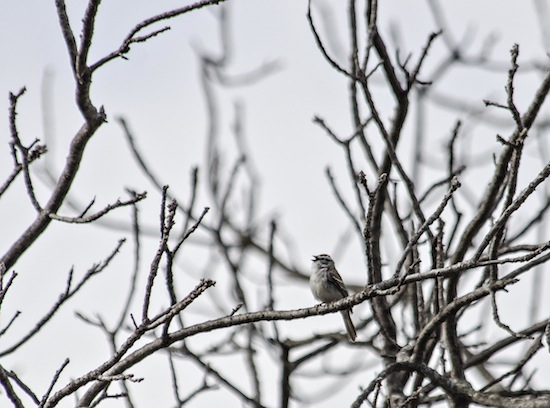Blooms are behind in late spring at the Arboretum

Migratory birds like the chirping sparrow have returned to the Arboretum on schedule but tree buds and many wildflowers have not.
Photo: Molly Fifield Murray
Deep into what is shaping up as the latest spring on record at the UW Arboretum, small victories over winter are important. Even if they don’t count.
“This is the first time we’ve seen a pasque flower blooming,” Molly Fifield-Murray, outreach program manager at the Arboretum, said last week. “But it’s not the one we watch for record-keeping. So we haven’t actually, officially seen a pasque flower bloom yet.”
Blooms on the Arboretum’s pasque flower of record — and a long list of spring flowers of record — have refused to open petals in the presence of the team of rangers and stewards and naturalists who take note of those first events of the season.
“Most of the woodland wildflowers are as late as they have ever been, and some are later than they have been in the last decade,” Murray said. “Bloodroot, red maple, toothwort, we haven’t recorded any blooms yet for any of them yet this year.”
That makes 2013’s pasque flower blooming later by nearly a week than any mentioned in either the Arboretum’s record (which began in earnest in 2000) or the paper that record draws on as inspiration: “A Phenological Record For Sauk And Dane Counties, Wisconsin, 1935-1945,” published by Arboretum founder and UW–Madison Professor Aldo Leopold and student Sara Elizabeth Jones.
The Arboretum keeps the record to satisfy science and soul, a dual purpose for which Leopold is well known. The introduction to the Leopold and Jones work on phenology (the study of plant and animal life cycles) includes a selection from what they called “its first paper, published about 974 B.C.”:
“For, lo, the winter is past.
“The rain is over and gone:
“The flowers appear on the earth;
“The time of the singing of birds is come
“And the voice of the turtle is heard in our land.”
(Solomon, 2:12)
Last week’s bloom count lacked forsythia, long past its historical average of April 10 in Leopold’s study and March 9 in the Arboretum’s recent work and a latest date of April 20 for Leopold and April 15 at the Arboretum. The pale purple of hepatica held out past its April 17 record. Dutchman’s breeches, bloodroot, toothwort, white violets and Pennsylvania sedge were all reaching the record late dates for production of pollen of flowers.
Even in the Wisconsin Native Plant Garden — residents of which don’t count for bloom-tracking purposes, because of heat from the nearby visitors center and not-entirely-natural sun and soil environment — was still well behind schedule for waking up as the weekend’s warming trend arrived.
“Generally, we’re seeing six or seven of the woodland flowers blooming at this time, but right now we’re seeing zero,” said Susan Carpenter, the Arboretum’s native plant gardener.
The Arboretum’s results are certainly not alone among spring time-keepers.
“The same thing is happening up at the Leopold shack” near Baraboo, said Stan Temple, who has kept up his research on phenology as an emeritus professor of conservation. “It has been one of the latest dates for most of the things that we keep track of.”
March and April ran close to five degrees colder than average, but, as Temple notes, a late spring is no strange thing in Wisconsin.
“I just picked a page from Aldo Leopold’s journal for the first week in May, and he had recorded two inches of snow overnight at the shack,” he said. “I’ve heard May is predicted to be normal, which will bring the average for spring up and move the flowers and trees in the right direction.”
However, this year stands in stark contrast to many in recent memory.
“It seems even later because our recent comparisons have been so, so early,” Carpenter said. It was just last year we set so many of the earliest dates we’ve seen.”
Visitors to the Arboretum should see blooms soon, as the mercury has risen precipitously, and there are already plenty of birds arriving.
“The long-distance migrants are least affected by weather,” Murray said. “Birds like the brown thrasher and chipping sparrow are here on time. They just have to sit in some empty branches for a while the plants catch up.”
Ditto for Arboretum visitors.
“We have so few. We’re so weather-dependent,” Murray said. “But soon we will have so many people, because they’re just starved for some spring.”
